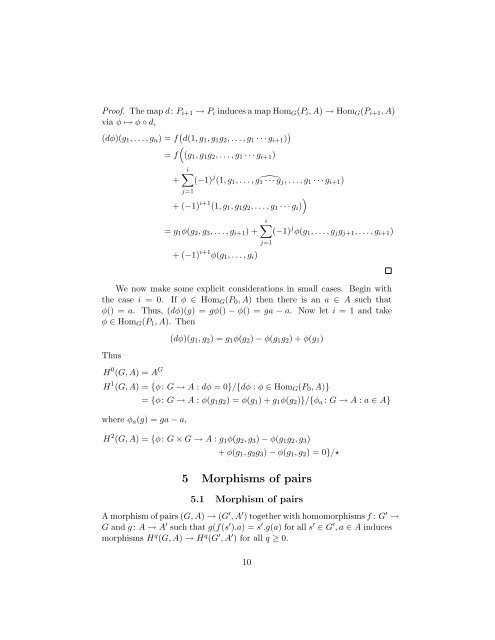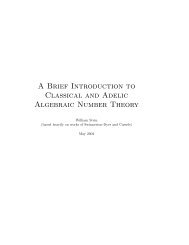A Short Course on Galois Cohomology - William Stein - University of ...
A Short Course on Galois Cohomology - William Stein - University of ...
A Short Course on Galois Cohomology - William Stein - University of ...
Create successful ePaper yourself
Turn your PDF publications into a flip-book with our unique Google optimized e-Paper software.
Pro<strong>of</strong>. The map d: Pi+1 → Pi induces a map HomG(Pi, A) → HomG(Pi+1, A)<br />
via φ ↦→ φ ◦ d,<br />
(dφ)(g1, . . . , gn) = f d(1, g1, g1g2, . . . , g1 · · · gi+1) <br />
= f<br />
+<br />
<br />
(g1, g1g2, . . . , g1 · · · gi+1)<br />
i<br />
j=1<br />
(−1) j (1, g1, . . . , g1 ·<br />
· · gj, . . . , g1 · · · gi+1)<br />
+ (−1) i+1 <br />
(1, g1, g1g2, . . . , g1 · · · gi)<br />
= g1φ(g2, g3, . . . , gi+1) +<br />
+ (−1) i+1 φ(g1, . . . , gi)<br />
i<br />
j=1<br />
(−1) j φ(g1, . . . , gjgj+1, . . . , gi+1)<br />
We now make some explicit c<strong>on</strong>siderati<strong>on</strong>s in small cases. Begin with<br />
the case i = 0. If φ ∈ HomG(P0, A) then there is an a ∈ A such that<br />
φ() = a. Thus, (dφ)(g) = gφ() − φ() = ga − a. Now let i = 1 and take<br />
φ ∈ HomG(P1, A). Then<br />
Thus<br />
H 0 (G, A) = A G<br />
(dφ)(g1, g2) = g1φ(g2) − φ(g1g2) + φ(g1)<br />
H 1 (G, A) = {φ: G → A : dφ = 0}/{dφ : φ ∈ HomG(P0, A)}<br />
= {φ: G → A : φ(g1g2) = φ(g1) + g1φ(g2)}/{φa : G → A : a ∈ A}<br />
where φa(g) = ga − a,<br />
H 2 (G, A) = {φ: G × G → A : g1φ(g2, g3) − φ(g1g2, g3)<br />
+ φ(g1, g2g3) − φ(g1, g2) = 0}/⋆<br />
5 Morphisms <strong>of</strong> pairs<br />
5.1 Morphism <strong>of</strong> pairs<br />
A morphism <strong>of</strong> pairs (G, A) → (G ′ , A ′ ) together with homomorphisms f : G ′ →<br />
G and g : A → A ′ such that g(f(s ′ ).a) = s ′ .g(a) for all s ′ ∈ G ′ , a ∈ A induces<br />
morphisms H q (G, A) → H q (G ′ , A ′ ) for all q ≥ 0.<br />
10
















